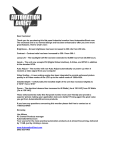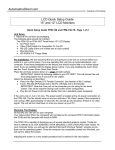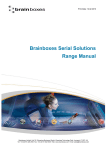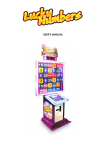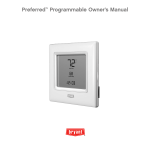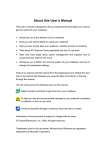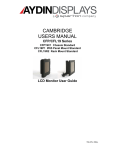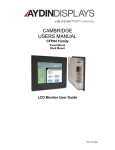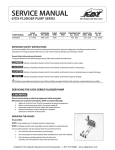Download Automationdirect.com FPM-180 User guide
Transcript
FPM-120 FPM-120-TS LCD Monitor User Guide Revised 12/02 FPM-120 & FPM-120-TS Table Of Contents Section 1 Introduction About LCD Monitors Product Safety Precautions Section 2 Display Setup Included Parts Connecting Your Display Section 3 Getting Started Display Features Getting Started Adjusting the Display Using the Auto-Adjust OSD (On Screen Display) Adjustments Section 4 Touch Screen Set up Introduction to Touch Screens Touch Screen Driver Installation Windows 98 Windows NT 4.0 Windows 2000 Windows XP Section 5 Mounting Instructions Section 6 Trouble Shooting Tips Section 7 Cleaning and Maintenance Section 8 Appendices A-VGA Pin Assignment B-RS-232 Pin Assignment C-General Specifications D-Mounting Dimensions 1 Section LCD Introduction About LCD Monitors What you gain by using an LCD monitor for your industrial display is the future of display technology. CRTs although they have dropped in cost significantly, do not offer the performance, reliability, and mounting options available with LCDs. LCD monitors consist primarily of an LCD, video board and a backlight. The LCD determines to a large extent the viewing angle, brightness and contrast. Beyond that it is the function of the video board, which converts the analog RGB (Red, Green, Blue) signals from a standard video card to a high quality, digital RGB that the LCD can display. LCD monitors can can be set for one or more of the following resolutions: VGA: 640 x480 SVGA: 800x600 XGA 1024 x 768 SXGA 1280 x1024 UXGA 1600x 1200 Note: The VGA acronym stands for Video Graphics Adapter. It is used to describe both the most common type of display interface used by PC’s and lowest resolution setting for this interface. Originally only the VGA [640x480] resolution was available on a VGA interface. Today all of the above interfaces are available on a VGA interface, but not all monitors support all resolutions. . The native resolution of the LCD is normally the maxium resolution that the LCD can display, and is the resolution that the LCD will exhibit the best display charastics Check the monitor specifications (Appendix C) for the resolutions supported by this monitor. Recently the video card has taken on a new role. It is the responsibility of this device to "scale" a particular video resolution to the "native" resolution of the LCD. This enables a computer set to output a VGA [640x480] resolution signal to be properly displayed on an XGA [1024x768] LCD screen. Without the scaling engine, the displayed picture would be in the center 1/3 of the LCD. The scaling engine mathematically converts the 640x480 to 1024x768. This my sound simple but it is in fact a complex algorithm that adjusts for different aspect ratios and pixel alignment, essentially smoothing text and graphics to produce a picture that is pleasant to the eye. All Automationdirect.com displays from 12.1" (800x600) to 18.1” (1280x1024) incorporate scaling engines in the converter card. Safety Precautions CAUTION: SHUT OFF YOUR TOUCH SCREEN BEFORE CLEANING!! IF YOUR DISPLAY IS A –TS MODEL, THAT IS A TOUCH SCREEN DISPLAY, THE SCREEN WILL BE ACTUATED BY CLEANING. PRESSING ON THE SCREEN WHILE CLEANING WILL BE SEEN AS A TOUCH TO THE SYSTEM WHICH COULD CREATE A POTENTIALLY DANGEROUS CONDITION!! Do not attempt to service this display yourself. The rear chassis has a seal so that non qualified personal will not expose themselves to dangerous voltages or other risks. To protect from electrical shock, unplug the display power supply from the wall before moving. Do not use this display near water Do not place any heavy objects on the power cords. Damage may cause electrical shock. Unplug the power supply from the wall or unit if one of the following conditions exists. o Power cord or plug is damaged or frayed o Liquid is spilled into the display or the display is exposed to rain or water. o The display does not operate normally when the operating instructions are followed. o The display has been dropped or the enclosure has been damaged. o The display exhibits a distinct change in performance, indicating a need for service. Ensure that sufficient space is available around the display to provide air circulation for cooling. Ensure that the ambient air temperature will not exceed the specified maximum temperature. Do not expose the display to direct sunlight or heat. 2 Section Display Setup Included Parts Your LCD monitor package will consist of the primary components listed below. Open shipping container and lay all components on a flat clean surface. FPM-120(-TS) LCD Monitor 6 ft Video Cable 6 Ft AC Power Cable 6 ft RS232 Touch Interface Cable ( touch screen units only) 10-32 Mounting Hardware. (For use with Panel Mount) Documentation and Driver CD ROM Connecting Your Display 1. Connect all cables to the computer first. This includes the VGA cable, and if the unit has a touch screen, the RS 232 serial touch screen connection. 2. After connecting the cables between the LCD monitor and the computer, plug supplied AC power cord into a suitable AC outlet then into the LCD. 3. Power on the display. The On/Off switch is located where the AC power cord enters the unit 4. If your computer is off, turn on your computer. 5. Your display should now operate as a normal computer display, displaying the computers BIOS screens and booting into Windows or other operating system. Note: If for any reason the display goes blank and/or displays “out of Range” or “No Input Signal” message on the screen, your computer or video source may be putting out a signal that is incompatible with the FPM-120(-TS). If this happens, reboot the computer with the previous display and adjust the display settings to be within the FPM-120(-TS) specifications (see Appendix C). Below is are the most common reasons a display may not operate correctly: 1. The resolution is to high or low for the LCD. 2. The refresh rate is set to high. Refresh on an LCD is different than a CRT. Set the refresh to 60Hz. CRT’s need a high refresh rate to avoid flicker. The refresh rate has no impact on an LCD. 3. The power source is incorrect, or there is no power. Check if the rear LED is ON or blinking. If the LED is not lit, check to be sure there is power to the unit. 4. The unit is malfunctioning. If you believe this to be true, disconnect the video cable from the rear of the LCD and connect to a known good display. If the computer display is working satisfactory and the video is within the appropriate range, then contact AutomationDirect.com technical support. 3 Section Getting Started Display Features The FPM-120(-TS) is capable of displaying 256K colors in a continuous spectrum. The high contrast LCD enhances the image with no geometric distortion. FPM-120(-TS) Series directly accepts an analog 5 wire RGB with separate H/V. This is the standard PC video signal. The FPM-120(-TS) Series is auto synchronous adjusting the display to the appropriate input between VGA or SVGA.. The FPM-120(-TS) Series is supplied with a Anti-Glare Touch Screeen [TS models] or an Anti-Glare impact window on non touch screen models. The FPM-120(-TS) Series has an integrated 115/220VAC power supply as standard on all models. Adjusting the Display The FPM-120 (-TS) Series display has an embedded microprocessor in the converter card [this is the electronics that drives the LCD]. In most cases the unit will require very little if any user intervention to operate correctly. That is, produce a sharp stable picture. The micoprocessor in the display has the capability to adjust itself to the computer to which it is attached. If the picture is not satisfactory, the first step is to allow the unit to attempt to adjust itself to your computer. Located on the rear of the unit is a membrane keypad used for adjusting the display. See figure 1 below: Menu Select Figure 1 Using the Auto-Adjust Once you have the unit displaying the resolution you desire for your application do the following: Press and release the “Select” button on the membrane. This will place the unit into a “Geometry Auto Adjust” mode. This operation will adjust the picture so it is centered both vertically and horizontally on the LCD screen. It will also make the necessary adjustments to the internal clock timing so that the picture is stable (without any decernable pixel jitter). After having completed this step you may wish to adjust the color balance. This procedure adjusts for any imbalance in the Red, Green, and Blue levels from the video cable or video card. This is accomplished using the LCDs OSD ( On Screen Menu) system. OSD (On Screen Display) Adjustments There are four membrane buttons (see Fig 1, above) located on the rear of the unit. They will activate the OSD and allow navigation to all adjustments if your unit requires adjustment. OSD Layout Main Menu Automatic Adjust Horizontal Position Vertical Position Horizontal Size Phase Brightness Contrast Color OSD Language Advanced Cancel Component Being Adjusted Geometry & Color Balance Horizontal position Vertical Position Horizontal Size Phase Brightness Contrast Red, Green, Blue Levels English, Espanol, Deutsch, Francais, Italiano Factory Preset, OSD Hor. Pos., OSD Vert. POS. All adjustment follows the basic adjustment procedure outlined below. If during adjustment you encounter difficulity. Exit the Menu system by pressing the Menu button and press the Select to Auto Adjust the unit. To adjust the Auto Color Balance: 1. Press the Menu button. 2. Press Select to Highlight this Sub Menu 3. Press the to highlight Auto Color Balance. 4. Press the Select button. The unit will test your video color balance and adjust it accordingly. When complete press Menu to Exit the OSD Menu system When you press the “Menu” the new settings are saved and your setting will be stored in the unit’s non-volatile memory. Following are complete instructions on how to adjust each individual function on the OSD menu: Automatic Adjustment Press Menu and the automatic adjustment will be the first item to appear on the OSD. Hit Select and then press the Up/Down button to navigate to Geometry. Press Select again and the display will automatically adjust the geometry. Press the Up/Down button to Color Balance. Hit Select again and the display will automatically preset the color balance to a factory preset value. Horizontal Position Press Menu. Press the Up button to the second icon which is Horz. Pos Hit Select and then press the Up/Down button to achieve the desired position. The desired value will be graphically illustrated along with a digital value. When complete press Select and you are ready to move to the next adjustment. Vertical Position Press Menu. Press the Up button to the third icon which is Vertical Position. Hit Select and then press the Up/Down button to achieve the desired position. The desired value will be graphically illustrated along with a digital value. When complete press Select and you are ready to move to the next adjustment. Horizontal Size Press Menu. Press the Up button to the fourth icon which is Horizontal Size. Hit Select and then press the Up/Down button to achieve the desired size. The desired value will be graphically illustrated along with a digital value. When complete press Select and you are ready to move to the next adjustment. Phase Press Menu. Press the Up button to the fifth icon which is Phase. Hit Select and then press the Up/Down button to achieve the desired phase. The phase should be adjusted until the screen image is sharp and there is no When complete press Select and you are ready to move to the next adjustment. Brightness Press Menu. Press the Up button to the sixth icon which is Brightness. Hit Select and then press the Up/Down button to achieve the desired brightness level. The desired value will be graphically illustrated along with a digital value. When complete press Select and you are ready to move to the next adjustment. Contrast Press Menu. Press the Up button to the seventh icon which is Contrast. Hit Select and then press the Up/Down button to achieve the desired contrast level. The desired value will be graphically illustrated along with a digital value. When complete press Select and you are ready to move to the next adjustment. Color Color temperature adjustments allows the user to adjust for desired white balance. This can be achieved by adjusting the Color Temperature control or adjusting the individual Red, Green or Blue controls. Press Menu. Press the Up button to the eight icon which is Color . Hit Select and then press the Up/Down button to select the Color Temperature. Hit Select again and adjust the Up/Down button and adjust to one of the desired six digital values. The six digital values are graphically illustrated. When complete press Select and you are ready to move to the next adjustment. If your require a unique white balance, you can adjust the individual colors to achieve this value by proceeding with the following adjustments. Advanced Settings Red Press Menu. Press the Up button to the eight icon which is Color. Hit Select and then press the Up/Down button to select Red. Hit Select again and adjust the red value which is graphically illustrated along with a digital value. When complete press Select and you are ready to move to the next adjustment. Blue Press Menu. Press the Up button to the eight icon which is Color. Hit Select and then press the Up/Down button to select Blue. Hit Select again and adjust the blue value which is graphically illustrated along with a digital value. When complete press Select and you are ready to move to the next adjustment. Green Press Menu. Press the Up button to the eight icon which is Color. Hit Select and then press the Up/Down button to select Green. Hit Select again and adjust the green value which is graphically illustrated along with a digital value. When complete press Select and you are ready to move to the next adjustment. Optional Settings OSD Language This function allows you to convert from English to the following languages. Espanol, Deutsch, Francais, Italiano. If you desire one of these languages, proceed to adjust as follows. Espanol will be used as an example. Espanol Press Menu. Press the Up button to the ninth icon which is OSD Language. Hit Select and then press the Up/Down button to select Espanol. Hit Select again and the display will convert all text to Espanol. When complete press Select and you are ready to move to the next adjustment 4 Section Touch Screen Setup Introduction to Touch Screens Touch screen interfaces have become the standard interface in the past 5 years. They are, rugged, reliable, extremely flexible and easier than ever to implement! The universal acceptance of the Windows GUI [Graphical User Interface] along with the extensive use of a mouse interface has significantly accelerated the use of a touch interface. Basically think of your touch screen as if it were a mouse. AutomationDirect.com touch systems are mouse emulators. By installing a software driver and connecting to a serial port, the touch screen will support all the primary mouse functions: The FPM-180(-TS) touch screen interface, is a high resolution, analog resistive. Following is a quick explanation of what all this means. High Resolution: The touch screen resolution is 400 ppi [points per inch] Analog Resistive: The actual touch glass is an analog device. Meaning there is a very low voltage applied to the X and Y axis of the touch screen. This current is applied to ITO [Iridium Tin Oxide] that is sputtered onto a polyester membrane. When you touch the screen you are changing the resistance on both the X and Y axis, producing an analog value that references a particular location. This type of screen can be activated with a gloved finger or mechanical stylus. The touch screen itself is connected to electronics [internal to the display unit] that provide the Analog to Digital conversion. When the screen is touched, the electronics convert the analog voltage to a digital value and add a "Mouse Click". This touch data is sent out from the display serial port to the PC serial port where the touch driver presents the data to the operating systems as if it were from a normal PC mouse. When the touch is released the new XY location is sent along with a "Mouse Up Click". The touch screen interface to the PC is RS-232, so the recommend maximum distance from the PC is 50 feet., The driver and and interface have been tested to 50 Ft. using high quality cables. High quaility cables and connectors are important, especially if field connections are made. Poor quality cables will drastically reduce the performance of the RS-232 interface. The touch driver default baud rate is 9600. Touch Screen Setup and Configuration: If the unit does not have a touch screen, your configuration is complete. If your display is fitted with the optional touch screen interface, the following section will outline installation and set up. This system requires no special software knowledge, and can be installed and set up in minutes. The following section gives a detailed explanation of the software setup and configuration Touch Screen Driver Installation for Windows 98 Required items to know or have to install the Touch Driver. What Operating System you are using. Windows 98 What Serial Port you are connected to. Usually COM 1 or COM 2 The type of touch screen. Smartset The CD-ROM or Floppy disk included with the system. Touch Screen Driver Installation for Windows 98 Insert the provided CD Select Link to the Windows 98 driver Select Open from the Windows dialog box. Select SmartSet Controller for Com1 or Com2 Remove the CD. Restart the computer; you will be prompted to calibrate the touch screen. Touch each of the 3 targets as directed. If the unit does not respond to your calibration touches then you have probably selected the wrong COM port. If so, reinstall the driver and selecting the correct COM port. You are now ready to use your touch screen. Note 1: The touch screen calibration information is maintained in the computer. If you change computers, you will need to reinstall the touch screen driver software and recalibrate. Note 2: If for any reason the touch screen performance is unsatisfactory, you can recalibrate at any time. This is done from the ELO icon under the Windows control panel Touch Screen Driver Installation for Windows NT 4.0 Required items to know or have to install the Touch Driver. What Operating System you are using. Windows NT 4.0 What Serial Port you are connected to. Usually COM 1 or COM 2 The type of touch screen. Smartset The CD-ROM or Floppy disk included with the system. Touch Screen Driver Installation for Windows NT 4.0 Insert the provided CD Select Link to the Windows NT driver Select Open from the Windows dialog box. Select Next Select Yes - To the license agreement Select Next - To the default installation folder Select Next - For Single Monitor installation Select the Com Port to which the touch interface is connected and Next Select Finish Remove the CD. Restart the computer. You will be prompted to calibrate the touch screen. Touch each of the 3 targets as directed. If the unit does not respond to your calibration touches then you have probably selected the wrong COM port. If so, press the Esc key on the keyboard to exit. Go to the ELO icon under Windows Control Panel. Select the correct Com Port, and Restart the computer. If this fails, reinstall the driver and select the correct COM port Once restarted, select the ELO icon under Windows Control Panel Select Calibrate, and then touch each of the 3 targets as they are displayed. You are now ready to use your touch screen. Note 1: The touch screen calibration information is maintained in the computer. If you change computers, you will need to reinstall the touch screen driver software and recalibrate. Note 2: If for any reason the touch screen performance is unsatisfactory, you can recalibrate at any time. This is done from the ELO icon under the Windows control panel Touch Screen Driver Installation for Windows 2000 Required items to know or have to install the Touch Driver. What Operating System you are using. Windows 2000 What Serial Port you are connected to. Usually COM 1 or COM 2 The type of touch screen. Smartset The CD-ROM or Floppy disk included with the system. Touch Screen Driver Installation for Windows 2000 Insert the provided CD Select Link to Windows 2000 driver Select Open from the Windows dialog box. Select Next Select Yes - To the license agreement Select the Com Port to which the touch interface is connected and Next Select Next, the driver will now start to install. Select YES - To continue Select Finish Remove the CD. Select YES to Restart. When the system restarts touch each of the 3 targets as directed. If the unit does not respond to your calibration touches then you have probably selected the wrong COM port. If so, press the Esc key to exit. Go to the ELO icon under Windows Control Panel. Select the correct Com port, and restart the computer. Once restarted, select the ELO icon under Windows Control Panel Select Align and Calibrate; then touch each of the 3 targets as directed. You are now ready to use your touch screen. Note 1: The touch screen calibration information is maintained in the computer. If you change computers, you will need to reinstall the touch screen driver software and recalibrate. Note 2: If for any reason the touch screen performance is unsatisfactory, you can recalibrate at any time. This is done from the ELO icon under the Windows control panel Touch Screen Driver Installation for Windows XP Required items to know or have to install the Touch Driver. What Operating System you are using. Windows XP What Serial Port you are connected to. Usually COM 1 or COM 2 The type of touch screen. Smartset The CD-ROM or Floppy disk included with the system. Touch Screen Driver Installation for Windows XP Insert the provided CD Select Link to XP driver Select Open from the Windows dialog box. Select Yes - To the license agreement Select the Com Port to which the touch interface is connected and Next Select Next, the driver will now start to install. Select YES - To continue Select Finish Remove the CD Select YES to Restart Go to the ELO icon under Windows Control Panel. Verify the Com Port is correct Select Align; then touch each of the 3 targets as directed. If the unit does not respond to your calibration touches then you have probably selected the wrong COM port. If so, press the Esc key to exit. Select the correct Com port, and restart the computer, then align the touchscreen. You are now ready to use your touch screen. Note 1: The touch screen calibration information is maintained in the computer. If you change computers, you will need to reinstall the touch screen driver software and recalibrate. Note 2: If for any reason the touch screen performance is unsatisfactory, you can recalibrate at any time. This is done from the ELO icon under the Windows control panel 5 Section Mounting Instructions Panel Mounting Procedure 1. Cut and drill the panel (refer to Figure 2; Panel Mount Drawing Appendix D). Measurements are in inches. A template of the hole pattern has been supplied with your monitor to assist in making the mounting holes accurately. Also, there is an AutoCad .dxf file included on the provided CD. This computer file can be used in a design drawing or forwarded to your panel fabricator for the proper mounting 2. If access to the side of the monitor is not available following installation, attach the power and video cables to the side of the monitor at this time. 3. Install the monitor in the prepared cutout. 4. Install the washers and lock nuts supplied with the monitor. Note: Use #10-32 nuts for mounting. 5. Tighten all mounting nuts evenly to a torque of 24 inch-pounds. ATTENTION: Mounting nuts must be tightened to a torque of 24 inch-pounds to provide panel seal and avoid potential damage. AutomationDirect.com assumes no responsibility for water or chemical damage to the monitor or other equipment within the enclosure due to improper installation. 6. Attach the power, video and touch screen cables (if this is a –TS unit) to the side of the monitor. Figure 2: Panel Mount Drawing 6 Section No Picture Troubleshooting Tips The signal cable should be properly connected to the FPM-120(-TS) and computer. Try disconnecting the video cable from the display and connecting to another display if available to confirm the presence of proper video. Make sure power is connected to the proper AC source. Make sure the resolution mode is supported by the display and check display settings of the PC Confirm that the video cable is not defective. Image Persistence Image persistence occurs when a ghost of an image remains on the screen after the screen image has been changed. Unlike a CRT monitor, an LCD monitor’s image persistence is not permanent. To erase an image ghost, turn the monitor off for several hours. What happens is the the liquid crystals after extened periods of operation with take a “set”. To avoid this condition, install a screen saver progam on the computer Picture Quality & Image Stability Check for proper video cable for proper grounding and shielding. Check the signal source for proper signal. Check for proper adjustment of the Phase and Frequency controls. Check for proper recommended signal timing. Green LED not lit Check for proper power and power connections Display image is not properly sized Press the “Select” button to Auto Adjust the display Adjust the Vertical and Horizontal size controls via the OSD. (Reference setup adjustments) Ensure that a supported mode is selected on the display card or system being used. Consult the display card or system manual for proper video. Image will not adjust Video timing outside of range. Use the on-screen menu to adjust the Clock Setting. Make sure timing is within VESA standard. Slight distortion in text or Graphics Not working in native resolution. Display is present but “bars” Appear or roll across screen Ground loop problem between computer and display Vertical shaded bars on Screen image Horizontal size not properly adjusted. Adjust horizontal size Image is not stable. Monitor has incorrect or bad sync signals.. Interference from adjacent equipment. Check for proper video cable installation. Replace suspected faulty cable. Check to ensure that video source is within the display’s operating range. 7 Section Cleaning & Maintenance Cleaning CAUTION: SHUT OFF YOUR TOUCH SCREEN BEFORE CLEANING!! IF YOUR DISPLAY IS A –TS MODEL, THAT IS A TOUCH SCREEN DISPLAY, THE SCREEN WILL BE ACTUATED BY CLEANING. PRESSING ON THE SCREEN WHILE CLEANING WILL BE SEEN AS A TOUCH TO THE SYSTEM WHICH COULD CREATE A POTENTIALLY DANGEROUS CONDITION!! Occasionally clean the display panel and cabinet with a soft cloth dampened (not soaked) with a mild (non-abrasive) glass cleaner. Keep turning a fresh side of the cloth toward the screen surface to avoid scratching it with accumulated grit. Note: The solvent should be applied only to the cloth, and not directly on the monitor screen. Do not use paper products as they may scratch the surface. To minimize the risk of abrasion, allow the screen to air dry. Special care should be taken when cleaning a touch screen or polycarbonate shield that is installed over the screen. Abrasive and certain chemical cleaners can damage the surface. Never use alcoholic or ammoniac cleaners to clean the polycarbonate shield or a touch screen. Replacing a Line Cord To avoid shock and fire hazards, the monitor’s power cord should be replaced if the insulation becomes broken or if it develops a loose internal connection. Other Maintenance Qualified service personnel should perform all maintenance, except for the power cord replacement described above. 8 Appendices Section Appendix A – Video Pin Assignments Pin assignments for the HD15 video connector Pin 1 Pin 2 Pin 3 Pin 4 Pin 5 Pin 6 Pin 7 Pin 8 Red Video Green Video Blue Video Not Used Return Red Video Ground Green Video Ground Blue Video Ground Pin 9 Pin 10 Pin 11 Pin 12 Pin 13 Pin 14 Pin 15 No Connection Sync Ground Not Used Bi-Directional Data Horizontal Sync Vertical Sync Data Clock (SCL) Appendix B – RS-232 Pin Assignments Pin assignment for 9 Pin Optional Touch Screen Connector Pin 1 Pin 2 Pin 3 Pin 4 Pin 5 Pin 6 Pin 7 Pin 8 Pin 9 DCD RD (Rx) SD (Tx) DTR SG DSR RTS CTS NC Data Carrier Detect Receive Data Transmit Data Data Terminal Ready Signal Ground Data Set Ready Request to Send Clear to Send No Connection Appendix C –General Specifications FPM-120 & FPM-120-TS Active Screen Area Brightness Contrast Lamp Life Max Screen Resolution Native Resolution (Best Picture) View Angle L / R View Angle Up / Dn Power Req. Current Draw Installed Depth Chassis Construction Bezel Construction Bezel OD Bezel Finish Auto Adjust 5 Wire Touch Recessed Cable Exit Video Interface Colors Operating Temp Storage Temp Storage Humidity NEMA Front End Input power 9.69" x 7.25" 300 200:1 50K VGA-SVGA SVGA 55/55 40/45 90-264 VAC Auto-switching .15 / 120 VAC 2.38" 16 Ga SS Al Machined .250" 15" x 12.5" Black Textured Yes Yes Yes VGA (HD-15F) 256,000 0-50 0-60 10-95 4/12 20W Appendix D – Mounting Dimentions NOTES Model Number: _________________ Serial Number: _________________























